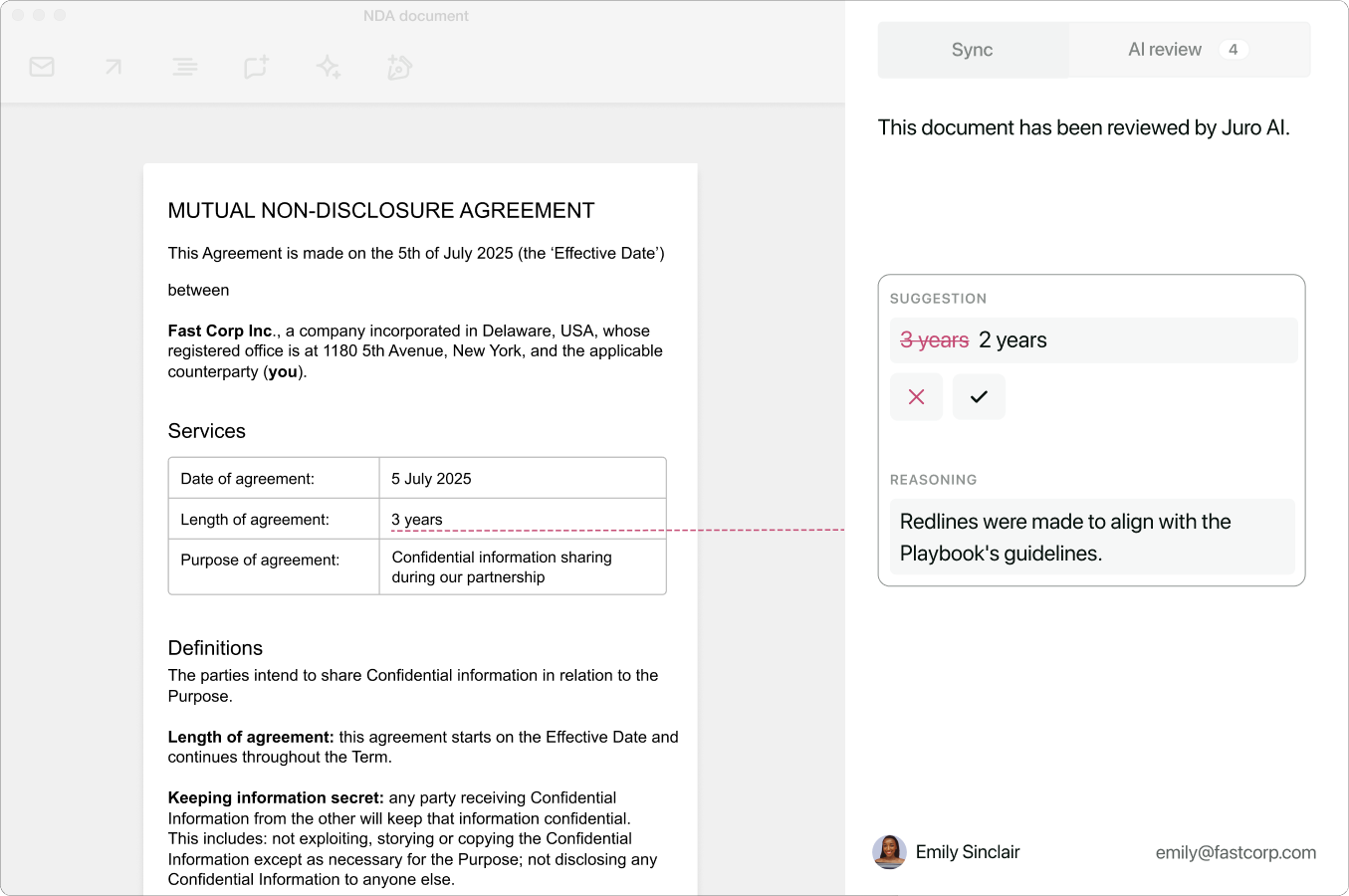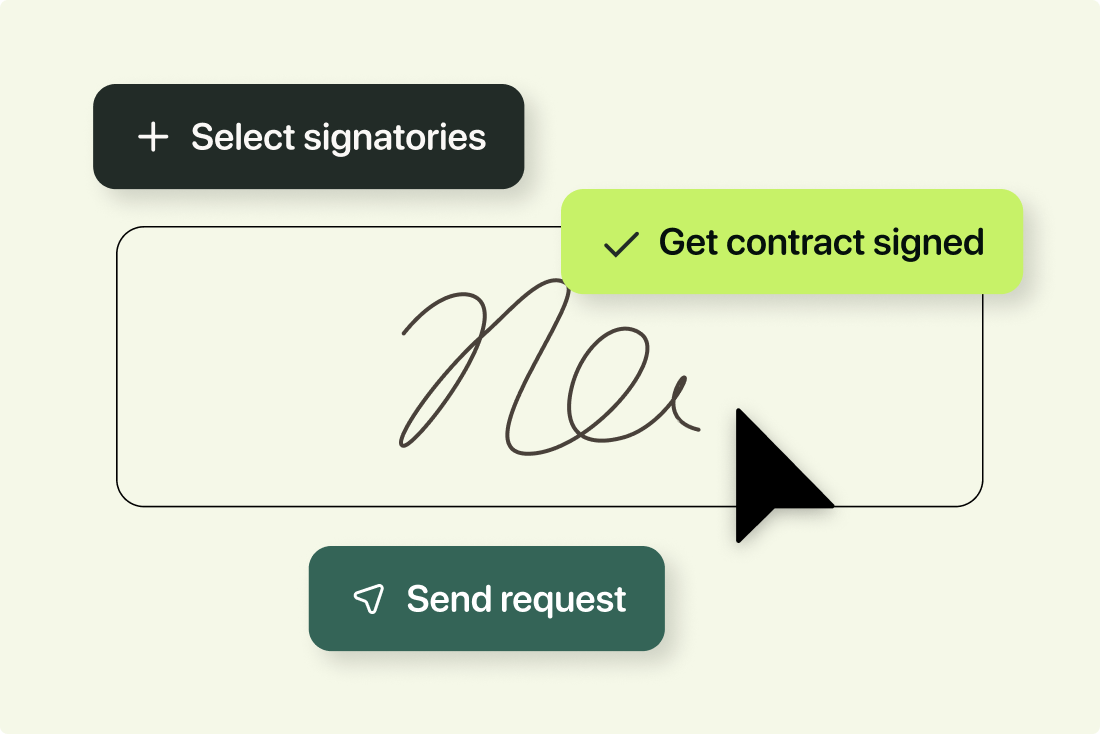Solutions
Customer Support
Resources
Redlining software is a technology that enables teams to make changes and revisions to documents electronically, rather than adding their redlines using pen and paper.
Just as electronic signatures have replaced wet signatures for modern businesses, redlining software replaces the traditional negotiation process, offering greater efficiency and flexibility for businesses that want to collaborate on agreements in real time.
Businesses are gravitating towards contract redlining software and moving away from manual contract redlining processes, like redlining in Word or Google Docs. Why? Well, there are a few reasons. Let's explore them now.
While Microsoft Word does provide some helpful features for contract redlining, the tool is built on static files, so it doesn’t offer the collaborative functionality required to work on agreements simultaneously. When using Microsoft Word for redlining, contract owners still need to:
With these limitations in mind, it’s clear that Word and Google Docs can’t deliver the advanced redlining features that growing businesses need to agree contracts quickly and efficiently.
If businesses want to streamline negotiations and remove blockers to growth, they will benefit from a digital redlining solution like Juro instead. Juro enables teams to agree contracts 10x faster than traditional tools, helping you get to capture revenue on your own terms.
To see Juro’s digital redlining functionality in action, hit the button below. Otherwise, keep reading to find out exactly what contract redlining software is and how it works.
Contract redlining software enables parties to add their comments and suggestions to a digital copy of a contract. In some cases, it can automate the markups altogether, eliminating the need for repetitive, manual review.
These comments and suggestions are also known as digital redlines, and they’ll flag which parts of the contract you’d like to change or negotiate with counterparties.
Depending on the type of contract redlining software you use, these comments and suggestions can be added and viewed in real time by the parties, making it quicker and easier to reach an agreement on a contract’s final terms.
Let’s run through how this works in a contract management platform like Juro, for example.
Juro enables teams to send contracts for internal and external review in just a few clicks, without leaving the platform. This can be done either by copying and pasting a unique link to the contract and sharing it, or by inserting the counterparty’s email address in the relevant box.
This is an inherent improvement on redlining in Word since it removes the need for you to save the draft copy of the contract in Word, log into your email address, upload it, and send it. Instead, you can share contracts for review and negotiation instantly, which saves time and reduces friction.
{{quote1}}
When the counterparty accesses the contract, they’ll be invited to either sign it straight away or add their redlines, comments, and suggestions.
Juro’s contract redlining software enables teams to:

All of this functionality makes adding and managing legal redlines seamless. Rather than sending your redlines across different versions of a document and various email threads, all of the digital redlines are captured in one place, creating a single source of truth during contract negotiations.
For in-house legal teams looking to adopt legal AI and further streamline redlining and contract review, Juro’s contract review agent unlocks even greater efficiency.
Juro’s contract review agent is designed to help in-house legal teams take the next step in automation by handling the most time-consuming and manual phase of the contract lifecycle: reviewing, redlining, and negotiating contracts. Instead of lawyers needing to manually comb through every clause, the AI review agent can:

The biggest advantage of using contract redlining software is that it enables teams to collaborate with counterparties in real time, rather than working separately on different versions of the document.
This can speed up the contract lifecycle since teams can address redlines as soon as they’re added to a contract. In a manual, Word-based workflow, parties would need to wait for updated versions of a contract to be saved and shared. These would then sit in email inboxes awaiting review, causing those all important deals to lose momentum.
{{quote2}}
Redlining software also gives contract owners greater control over which version of a contract is being worked on, and visibility into exactly who is using which versions, and which activities are happening in these.
For example, a redlining tool like Juro enables teams to scroll back through a contract timeline to review changes and compare versions. Juro users can access a detailed audit trail of user activity throughout the contract's lifecycle, or they can scroll back through different versions of a contract, with complete visibility into who created them and when.

Since all of the previous versions of a contract and the changes made are captured in full, contract redlining software eliminates the risk of data loss during negotiations.
It’s easy for requests to be lost when they’re shared via email chains or on the phone. But if you redline contracts in a platform like Juro, all of this data is captured by default, because all comments, edits, and suggestions are captured in one place.
{{quote3}}
Some stakeholders don’t need to be in the details of a negotiation, but they do need to approve final contracts before they’re signed. Advanced contract redlining software enables teams to control when these stakeholders are invited into the negotiation process for faster and more efficient redlining workflows.
A collaborative contract management platform like Juro offers businesses the opportunity to fully customize their contract approval workflows.
Juro users can set approval sequences where individuals are asked for their approval in a specific order. They can also set up approval workflows for individual templates, or for contracts that meet specific conditions.
{{quote4}}
Contract redlining software also delivers a better experience for counterparties. This is because Juro reduces friction throughout the contract negotiation process by bringing all communications into one platform, rather than asking counterparties to jump back and forth between several different tools.
Juro’s contract management platform is also intuitive and easy to use, making it easy for internal teams and counterparties to adopt and use.
As your business scales, so does the volume of contracts you manage. What once worked in Word or email threads quickly becomes unsustainable. Traditional editors can’t keep pace with growing workloads, leaving legal and business teams bogged down in repetitive edits and scattered feedback.
Inefficient review and redlining processes don’t just drain time — they stall deals, frustrate counterparties, and cause valuable opportunities to lose momentum. Every extra version, email chain, or lost comment is a step further away from execution.

That’s where centralized, collaborative redlining software makes all the difference. By bringing every comment, edit, and approval into one secure workspace, you create a single source of truth for negotiations. Add automation into the mix, and you unlock even greater benefits: consistent application of playbooks, stronger compliance with company policies, and less risk of human error.
Juro’s contract redlining solution is designed to meet the demands of fast-growing businesses. Our collaborative, flexible, and data-rich platform enables your team to move faster, close with confidence, and scale without the chaos of version control. With automated review and redlining, you shift your lawyers’ role from firefighting to strategic oversight — helping you agree contracts faster and more reliably.
To find out more, fill in the form below.
Lorem ipsum dolor sit amet, consectetur adipiscing elit. Suspendisse varius enim in eros elementum tristique. Duis cursus, mi quis viverra ornare, eros dolor interdum nulla, ut commodo diam libero vitae erat. Aenean faucibus nibh et justo cursus id rutrum lorem imperdiet. Nunc ut sem vitae risus tristique posuere.

